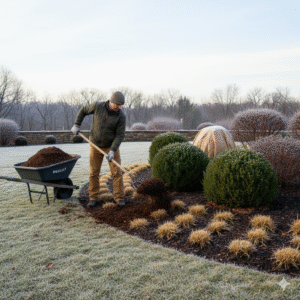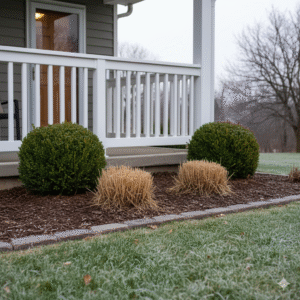Preparing Your Garden Beds for Winter, Part 2
We explained in our last post some essential steps to take to prepare your landscape beds for winter. If you missed that, you can read it here. We want to continue with some more helpful tips.

Month-by-Month Winter Prep Timeline
October
- Clean up summer annuals
- Plant spring bulbs
- Divide perennials
- Begin leaf collection for composting
November
- Complete soil amendments
- Apply winter mulch after first hard freeze
- Plant cover crops
- Protect tender perennials
December
- Final tool cleaning and storage
- Monitor mulch levels
- Check winter protection structures
- Plan next year’s garden
Common Winter Preparation Mistakes to Avoid
- Mulching too early: Wait until after the first hard freeze to prevent rodent nesting
- Over-fertilizing: Avoid high-nitrogen fertilizers in fall which encourage tender growth
- Pruning at the wrong time: Don’t prune spring-blooming shrubs in fall
- Forgetting about drainage: Ensure beds have proper drainage to prevent winter root rot
- Leaving diseased material: Always remove and dispose of diseased plants

Winter Interest and Wildlife Benefits
While preparing for winter, consider leaving some elements for visual appeal and wildlife:
- Seed heads: Leave ornamental grass and perennial seed heads for birds
- Brush piles: Create small brush piles for wildlife shelter
- Native plants: Many native species provide winter food and habitat
The National Wildlife Federation offers excellent resources on creating wildlife-friendly winter gardens.
Looking Ahead to Spring
Your winter preparation efforts will pay dividends come spring:
- Improved soil will be ready for early planting
- Protected perennials will emerge stronger
- Cover crops can be turned under for green manure
- Mulched beds will warm up faster and retain moisture
Get Your Winter Garden Supplies at Herbein’s
Ready to winterize your garden beds? Visit Herbein’s Garden Center for all your winter preparation needs:
- Premium organic mulches and compost
- Cover crop seeds
- Soil amendments and testing kits
- Winter protection materials
- Expert advice from our knowledgeable staff
Our team can help you select the right products for your specific garden conditions and answer any questions about winter preparation techniques.
Conclusion
Preparing your garden beds for winter is one of the most important tasks you can undertake as a gardener. By following these comprehensive steps – from cleaning and amending soil to applying protective mulch and planting cover crops – you’re not just protecting your plants from winter damage. You’re actively improving your soil, supporting beneficial wildlife, and setting the stage for a flourishing garden next spring.
Remember, successful winter preparation is about working with nature’s cycles, not against them. Take time this fall to properly winterize your beds, and you’ll be rewarded with healthier plants, richer soil, and a more productive garden for years to come.
For more gardening tips and seasonal advice, visit Herbein’s Garden Center or stop by our Emmaus location. Our experienced staff is always ready to help you achieve gardening success in every season.





